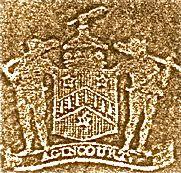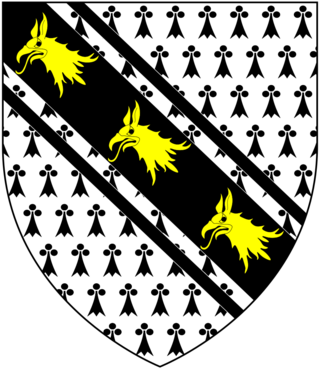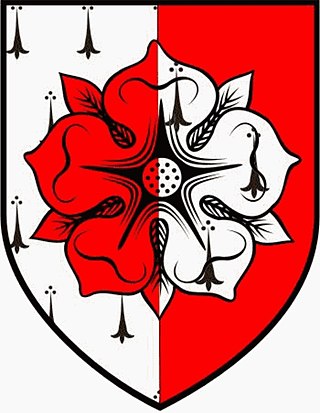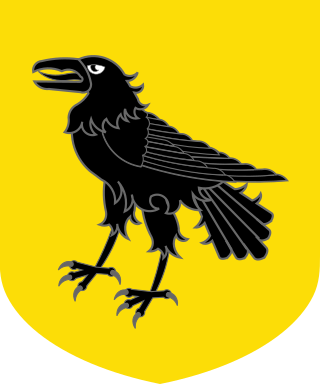
Wodehouse is an English surname and barony.

The Yonge Baronetcy, of Culliton in the County of Devon, was a title in the Baronetage of England. It was created on 26 September 1661 for the merchant and Member of Parliament, John Yonge. He was succeeded by his son Walter, the second Baronet. He was also a Member of Parliament. His son, the third Baronet, sat in the House of Commons for more than a quarter of a century. On his death the title passed to his son, the fourth Baronet. He was also a politician and served as Secretary at War. He is also remembered for his diaries. He was succeeded by his son, the fifth Baronet. Like his father he served as Secretary at War and was also Governor of the Cape Colony. The baronetcy became extinct on his death in 1812.

The Nightingale Baronetcy of Newport Pond is a title in the Baronetage of England and a rank in the British aristocracy. It was created by King Charles I of England, on 1 September (1628), and is one of the oldest baronetcies to remain active in England.

There have been three baronetcies created for persons with the surname Cooke, two in the Baronetage of England and one in the Baronetage of Ireland. One creation is extant as of 2013.
Sir Nicholas Hare of Bruisyard, Suffolk was Speaker of the House of Commons of England between 1539 and 1540.

The Hardres Baronetcy, of Hardres Court in the County of Kent, was a title in the Baronetage of England. It was created on 3 June 1642 for Sir Richard Hardres. The fourth Baronet, Sir William Hardres, was Member of Parliament for Kent and Canterbury. The title became extinct on the death of the fifth Baronet, William Hardres II, in 1764.
Sir William Williams, 6th Baronet of Faenol (Vaynol) was a Welsh politician and landowner elected as MP for Caernarvonshire from 1689 until his death.

Sir Ralph Hare, 1st Baronet of Stow Bardolph, Norfolk was an English politician who sat in the House of Commons variously between 1654 and 1672.

Sir Robert Dashwood, 1st Baronet (1662–1734) was an English politician.
Sir Thomas Hare, 2nd Baronet, was a member of the East Anglian gentry and a Member of the Parliament of England.
Sir Thomas Hare, 4th Baronet (1686–1760) Stow Bardolph, Norfolk was a British politician who sat in the House of Commons between 1713 and 1715.

Sir Ralph Cole, 2nd Baronet was an English politician.

The Assheton Baronetcy, of Lever in the County of Lancaster, was created in the Baronetage of England on 28 June 1620 for Ralph Assheton. The second Baronet sat as Member of Parliament for Clitheroe. The title became extinct on the death of the fourth Baronet in 1696.

The Stapylton baronetcy, or Stapleton, of Myton in Yorkshire, was created in the Baronetage of England on 22 June 1660 for Henry Stapylton.

The Bowyer baronetcy, of Knipersley in the County of Stafford, was created in the Baronetage of England in 1660 for John Bowyer. He sat as Member of Parliament for Staffordshire and Newcastle-under-Lyme. His elder son, the second Baronet, represented Warwick and Staffordshire in the House of Commons. His son, the third Baronet, died childless and was succeeded by his uncle, the fourth Baronet. On the latter's death in 1701 without surviving male issue the title became extinct.

The Tyrwhitt Baronetcy, of Stainfield in the County of Lincoln, was created in the Baronetage of England on 29 June 1611 for Philip Tyrwhitt. The fourth Baronet represented Grimsby in the House of Commons. The fifth and sixth Baronets both sat as Members of Parliament for Lincoln. The title became extinct on the latter's death in 1760.

The Corbet baronetcy, of Sprowston in the County of Norfolk, was created in the Baronetage of England on 4 July 1623 for John Corbet, of Sprowston. He was son of Sir Thomas Corbet, Kt, High Sheriff of Norfolk in 1612. He sat as Member of Parliament for Norfolk and Yarmouth. He was the elder brother of the regicide Miles Corbet. The title became extinct on the death of the third Baronet in 1661.

The Roberts baronetcy, of Glassenbury, Cranbrook, in the County of Kent, was created in the Baronetage of England on 3 July 1620 for Thomas Roberts, High Sheriff of Kent in 1621.

The Mackenzie Baronetcy, of Tarbat in the County of Ross, was created in the Baronetage of Nova Scotia on 21 May 1628 for John Mackenzie. His son, the 2nd Baronet, was created Earl of Cromarty in 1703; he resigned the baronetcy in favour of his younger son Kenneth, who was created a baronet in the Baronetage of Nova Scotia on 29 April 1704, with remainder to his heirs male whatsoever and with the precedence of 1628. The 3rd Baronet was one of the Scottish representatives to the 1st Parliament of Great Britain and later represented Cromartyshire. The 4th Baronet was Member of Parliament for Cromartyshire. In 1744 he succeeded to the Mackenzie baronetcy of Roystoun on the death of his uncle Sir James Mackenzie, 1st Baronet, of Roystoun.

The Kaye baronetcy, of Woodesham in the County of York, was created in the Baronetage of England on 4 February 1642 for John Kaye of Woodsome Hall, Almondbury, Yorkshire. He was a colonel of the Horse in the service of King Charles I during the Civil War. His title was forfeit under the Parliamentarian rule, but was restored after the return of the monarchy in 1660.
















